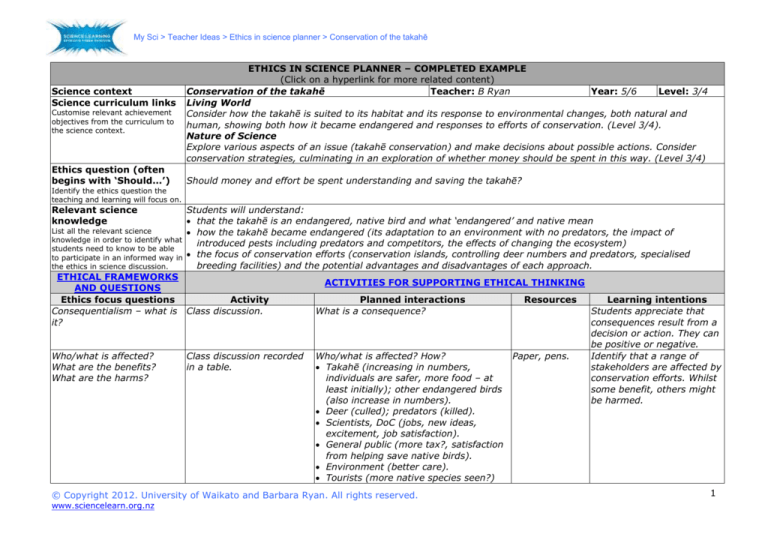
My Sci > Teacher Ideas > Ethics in science planner > Conservation of the takahē
Science context
Science curriculum links
Customise relevant achievement
objectives from the curriculum to
the science context.
Ethics question (often
begins with ‘Should…’)
ETHICS IN SCIENCE PLANNER – COMPLETED EXAMPLE
(Click on a hyperlink for more related content)
Conservation of the takahē
Teacher: B Ryan
Year: 5/6
Level: 3/4
Living World
Consider how the takahē is suited to its habitat and its response to environmental changes, both natural and
human, showing both how it became endangered and responses to efforts of conservation. (Level 3/4).
Nature of Science
Explore various aspects of an issue (takahē conservation) and make decisions about possible actions. Consider
conservation strategies, culminating in an exploration of whether money should be spent in this way. (Level 3/4)
Should money and effort be spent understanding and saving the takahē?
Identify the ethics question the
teaching and learning will focus on.
Relevant science
knowledge
Students will understand:
that the takahē is an endangered, native bird and what ‘endangered’ and native mean
List all the relevant science
how the takahē became endangered (its adaptation to an environment with no predators, the impact of
knowledge in order to identify what
introduced pests including predators and competitors, the effects of changing the ecosystem)
students need to know to be able
the focus of conservation efforts (conservation islands, controlling deer numbers and predators, specialised
to participate in an informed way in
breeding facilities) and the potential advantages and disadvantages of each approach.
the ethics in science discussion.
ETHICAL FRAMEWORKS
ACTIVITIES FOR SUPPORTING ETHICAL THINKING
AND QUESTIONS
Ethics focus questions
Activity
Planned interactions
Resources
Learning intentions
Consequentialism – what is Class discussion.
What is a consequence?
Students appreciate that
it?
consequences result from a
decision or action. They can
be positive or negative.
Who/what is affected?
Class discussion recorded Who/what is affected? How?
Paper, pens.
Identify that a range of
What are the benefits?
in a table.
Takahē (increasing in numbers,
stakeholders are affected by
What are the harms?
individuals are safer, more food – at
conservation efforts. Whilst
least initially); other endangered birds
some benefit, others might
(also increase in numbers).
be harmed.
Deer (culled); predators (killed).
Scientists, DoC (jobs, new ideas,
excitement, job satisfaction).
General public (more tax?, satisfaction
from helping save native birds).
Environment (better care).
Tourists (more native species seen?)
.
© Copyright 2012. University of Waikato and Barbara Ryan. All rights reserved.
www.sciencelearn.org.nz
1
My Sci > Teacher Ideas > Ethics in science planner > Conservation of the takahē
What are possible harms
and benefits for different
stakeholders?
Are some consequences
greater or lesser than
others?
Noisy round robin
Rights and responsibilities:
What groups have rights
associated with this issue?
What are their rights?
Class sharing and
discussion
Do these groups also have
responsibilities? What are
their responsibilities?
Virtue ethics: Does saving
the takahē make us better
people? Why or why not?
Class sharing and
discussion
Ethical deliberation and
justification
Debate
Class sharing and
discussion
Small group discussion –
one person from each
group to share ideas with
the class.
Students work in small groups to build on Plus minus
and extend ideas generated in class
interesting
discussion.
(PMI)
Some benefit (takahē, other birds, DoC,
environment, tourism); some are harmed
(predators, deer, money spent on
conservation rather than other things,
land not available for other uses). How do
you decide what matters most?
Does the takahē have a right to survive
as a native NZ bird? What about natural
consequences (e.g., survival of the fittest,
leaving ‘nature’ to take its course)? How
have humans interfered with nature
process? (Not just protecting the takahē
but earlier by bringing predators to NZ).
Having brought predators to NZ, do we
(NZ Government) now have a
responsibility to help the takahē survive?
Does saving the takahē cause people to
become better citizens? In what way?
(More caring, more generous with time
and money, more supportive of
environmental protection/restoration.)
Students assigned to plus/minus groups
so they have to acknowledge views that
might be different to their own.
Different stakeholders are
affected differently; some
are harmed, some benefit.
Students begin to make
judgements by weighing
harms and benefits.
Students think about rights
from a historical perspective
– what occurred that is now
causing the takahē to
struggle to survive?
If the takahē has a right to
survive, whose responsibility
is it to see this happens?
Students appreciate virtues
can be developed through
ethical thinking – care,
generosity, valuing the
natural environment.
Students make a decision
and explain it to others,
consider others’ views.
Assessment
An individual report incorporating both the science and ethical considerations:
1. What is the takahē? (Include habitat, food, behaviour.)
2. How did the takahē become endangered? (Its history.)
3. What is being done to save the takahē?
4. Do you think it is important to spend money saving the takahē? Why or why not?
© Copyright 2012. University of Waikato and Barbara Ryan. All rights reserved.
www.sciencelearn.org.nz
2








